Bollwerk 178
Bollwerk 178 is a unique variant on a board with 178 squares. The goal of the game is to occupy the opponent’s end field (B1 and K18) with a piece or a bomb. Whoever captures all their opponent’s pieces or immobilizes their opponent also wins. There is no King in this variant.
Each player has 20 pieces and 25 supplementary stones at their disposal. The game board is in a constant state of change due to the supplementary stones.
There are three options for making a move:
- move one of the 20 pieces,
- move one of the 20 pieces and then place a supplementary stone with the same piece, or
- place a supplementary stone with one of the 20 pieces without having moved it before.
Placing supplementary stones
Each piece can drop off any of the supplementary stones, on any of the squares that it could move to. Either after the piece has been moved (point 2 above), or without moving the piece first (point 3 above). It is not possible to place a supplementary stone and then move the piece.
Example for point 2.
A player moves his King's Knight. He then has the option to place a supplementary stone from the new square it’s on. This is possible on all squares the King’s Knight could reach from his new position the next turn.
Example for point 3.
The player also has the option of not moving his King’s Knight and leaving it on its square. From there, the player can place an supplementary stone on a square that the King’s Knight can reach from his position.
A King’s Knight therefore places supplementary stones as part of his regular moves like most pieces (except: Guard, Spy, Cannon).
With the supplementary stones defense can be strengthened, possible lines of attack can be closed or the way of opposing pieces can be blocked. You can secure your end field, protect your pieces from opponents attackers or limited the opponent's possibilities of movement. Pieces can also be locked up. Due to the bombs and the Knight (the only piece that can remove blocks and arrows from the board), there usually is a long way of freeing them again.
Theoretically you can sacrifice 19 pieces and win with the last remaining one over an entire opposing team.
Setup

B1 and K18 are the end fields, the opponent's occupation of which ends the game.
The red shaded squares (B-D 2-4 and I-K 15-17) are the end zones. A player cannot place supplementary stones in their own end zone. The attacking player may place supplementary stones in the opponent’s end zone; the defender can blow them up with a bomb or remove them using the Knight.
Pieces
The supplementary stones:
Arrow:
Both players have 10 arrows at the start of the game. Each piece is capable of placing the arrow on a free square within its possibilities. The square is then occupied.
Only the Elephant and the King’s Knight can land on squares where an arrow has been placed. The arrow is destroyed and removed from the game. Jumping pieces can skip the arrow, all others are blocked by it.
Block:
Both players have 10 blocks at the start of the game.
Each piece is capable of placing the block on a free square within its possibilities. The square is then occupied.
No piece can move over a block. The only exception is the Cannon, which can capture over a block.
Elephants have the special ability to move past a block by taking an evasive step if the conditions for this are fulfilled (see description Elephant).
Red Border Arrow:
Both players have a red border arrow at the beginning of the game.
The red border arrow has the same characteristics as the normal arrow, with the difference that it can be collected by moving a piece to the square the red border arrow is placed in.
It is then placed back in the supply with the other supplementary stones.
The opponent can also collect a discarded red border arrow.
It can be blown up by a bomb and removed from the game.
King’s Knights and Elephants collect it like other pieces.
The red border arrow can also capture the Spy.
Red Border Block:
Both players have a red border block at the start of the game. This block has the same characteristics as the normal block, except that it can be recollected by moving a piece to the square the red border block was placed in. It is then placed back in the supply with the other supplementary stones. The opponent can also collect a discarded red border block.
It can also be blown up by a bomb.
Bomb:
Both players have 3 Bombs at the start of the game. Each piece is capable of placing the bomb within its possibilities. Whoever places a bomb on the opponent’s end field wins the game. Bombs can blow up arrows and blocks by placing them on their squares. The blasted arrow or block is then removed from the game together with the bomb used.
A new supplementary stone cannot occupy the now empty square in the opponent’s next turn after the explosion. However, a piece may move onto the square on the next move. Bombs may be used in your own end zone to blow up arrows or blocks placed there by the opponent.
Bombs can also be placed on free squares. They then have characteristics like an arrow, which means that jumping pieces can jump over it while the other pieces are blocked by it. A dropped bomb cannot be removed.
Pieces
Guard:
Both players has 10 Guards at the start of the game. Guards can move and capture one square forward vertically or forward diagonally. They can also move one square horizontally, but without being able to capture.
Guards can jump over their own guards as often as they like in all directions per move (this also allows them to move backwards).
They can also jump over an opponent’s Guard, which is always captured (only possible forward vertically and forward diagonally as with normal capturing).
From their starting row they can also move two fields forward (vertically and diagonally), but without being able to capture.
Guards are blocked by all supplementary stones.
A Guards can place supplementary stones to the spaces it could possibly move to, but at most over one of their own Guards (in all directions).
Forward vertically and forward diagonally, supplementary stones can also be placed over an enemy Guard.
The red square in the diagram means that this piece is the starting point when the options are displayed.

Gold Runner:
Each player has two Gold Runners. It moves and captures diagonally like the Bishop in chess, but with the added ability to change colour: the Gold Runner can enter directly adjacent squares of a different colour without being able to capture. The Gold Runner is blocked by all supplementary stones.
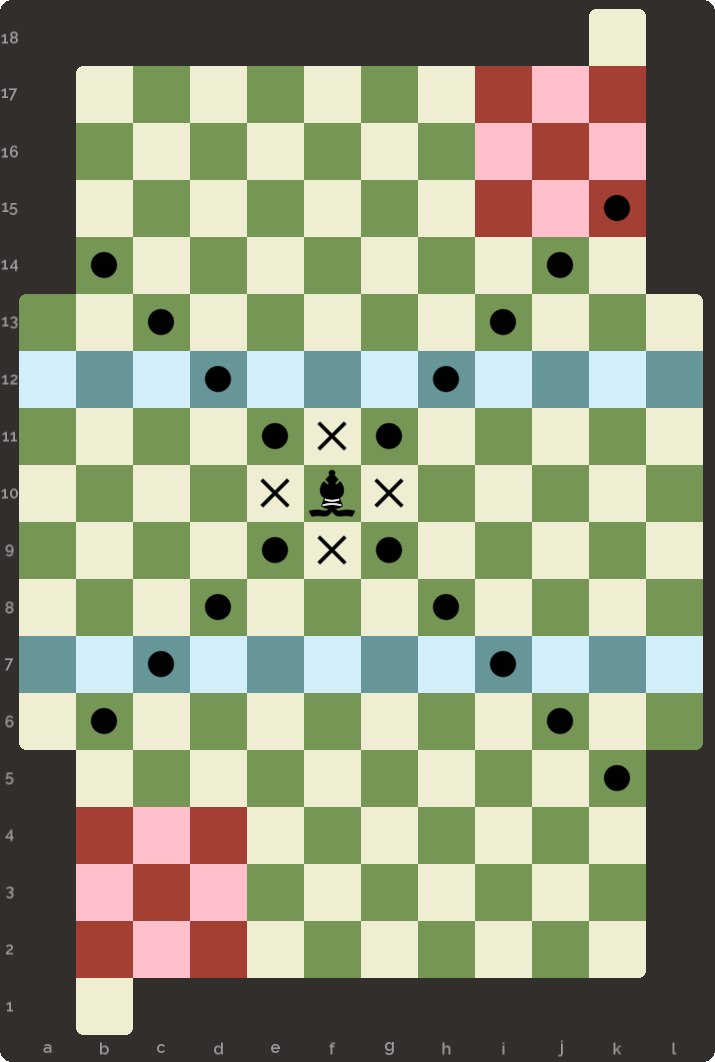
King’s Knight:
The King’s Knight can move and captures like a Knight or the King in classical chess. It can jump over all pieces, also over arrows and dropped bombs. It can move to a square that is occupied by an arrow. The arrow is destroyed and removed from the game.
If possible, the King´s Knight can jump past blocks (two squares horizontally and then one square vertically or vice versa).

Elephant:
The Elephant moves and captures one or two squares horizontally, vertically or diagonally. It can jump over other pieces, also over arrows and dropped bombs. The Elephant is prevented from moving by blocks. However, if an adjacent square next to the block is free, the Elephant can move past the block by taking an evasive step (see diagram). It can move to a square that is occupied by an arrow. The arrow is destroyed and removed from the game.
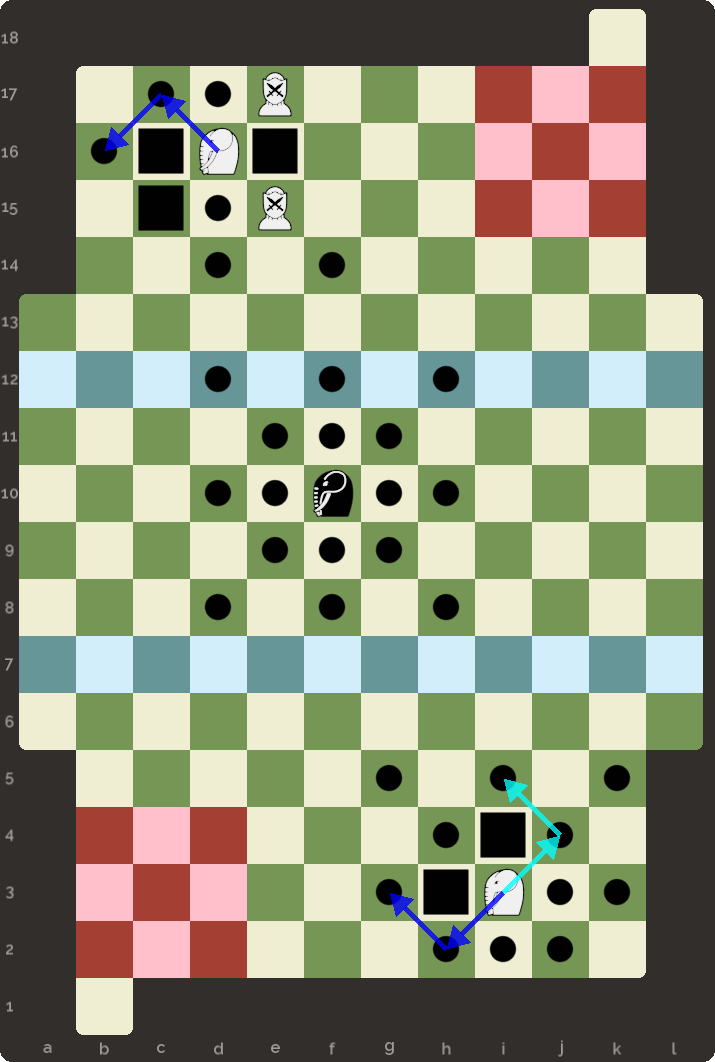
Queen:
The Queen moves and captures as in classical chess. The Queen is blocked by all supplementary stones.
Spy:
The Spy captures other pieces exclusively by jumping over them (same principle as in Halma). It can capture up to two pieces per move.
The Spy can move one square in any direction (like the King in chess- King move! ). It is not possible to capture this way.
In addition, the Spy can jump over his own and enemy pieces, supplementary stones (arrows and dropped bombs) for movement without limits during a move.
When capturing, however, the Spy may previously have only jumped over its own pieces or only over supplementary stones. It is also possible to jump right over the opponent.
If the first skipped opponent piece is not captured, a later capture in the same turn is not possible. The Spy is blocked by blocks.
The Spy is the only piece that can be captured by the arrow. The arrow is placed on the square by the Spy.
The Spy himself cannot capture the enemy Spy with the arrow.
After capturing, the Spy can make up to two more jumps to get out of the risk zone. It can also make a King move or choose the combination of a jump and a King move.
In this way the Spy also places supplementary stones.
One or two jumps far. Like a King or the combination of a jump and a King move (or vice versa).
In the opponent’s end zone, the arrow cannot capture the Spy, because the defender is not allowed to place supplementary stones there.
The two Guards on the red squares on the diagram can be captured.
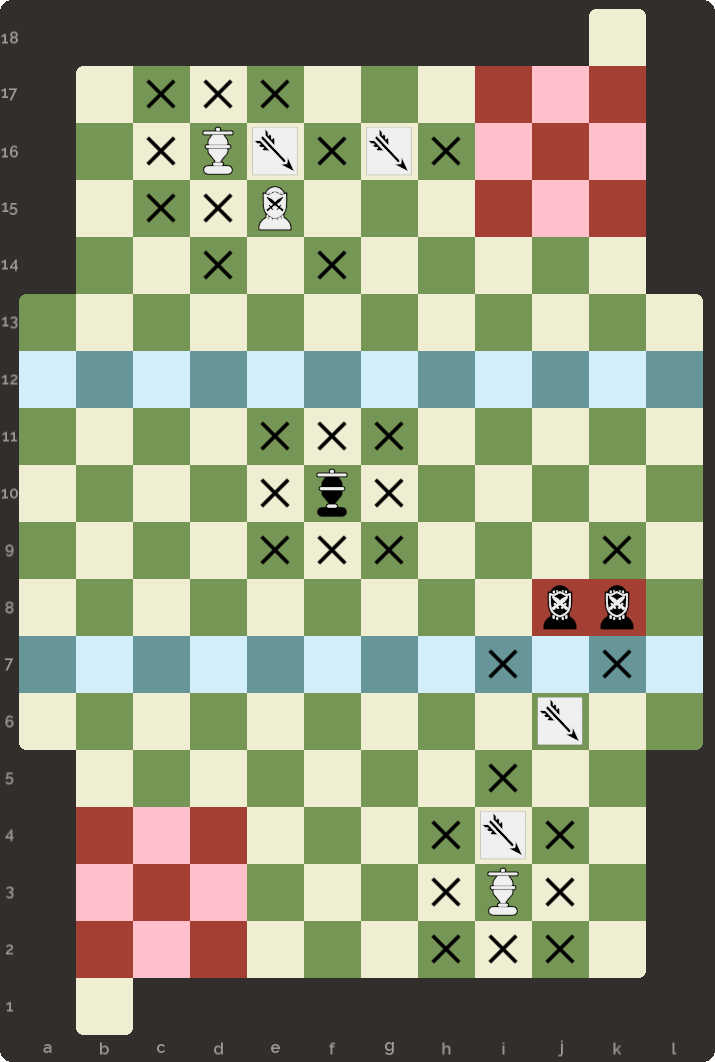
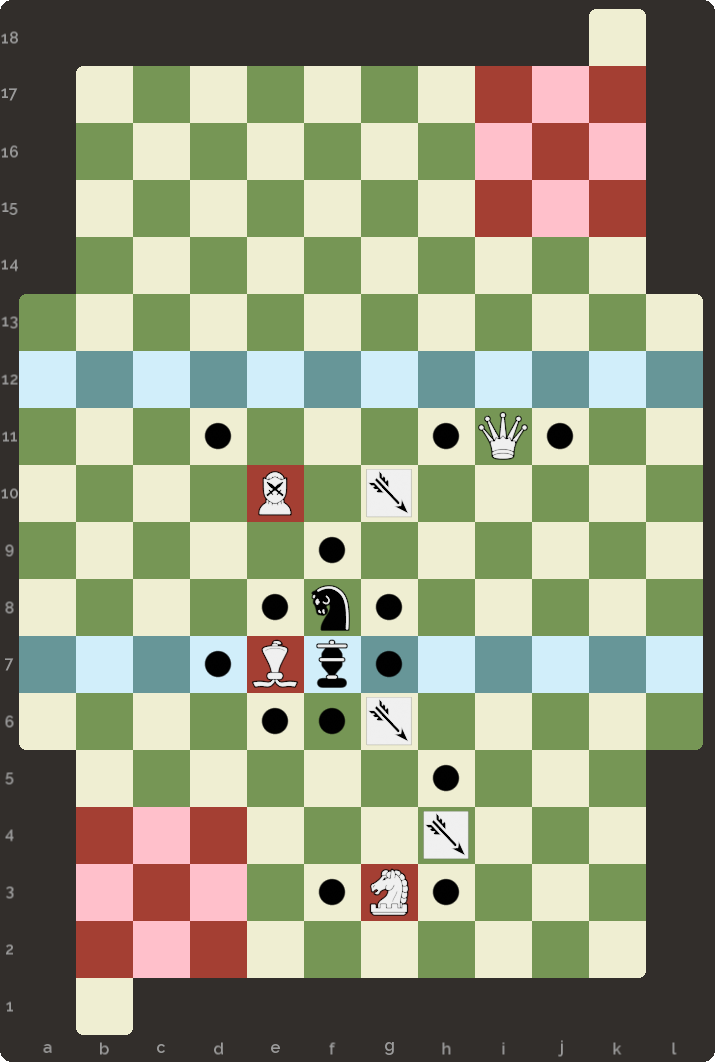
Here are all move options for the Spy market with a point. The Spy can capture the Chancellor, Marshal and the Guard, but not the Queen.
Marshal (or Archbishop):
The Marshal moves and captures like the Knight or Bishop in chess. As a Knight it can jump over all pieces, including arrows and dropped bombs. If possible, it can jump past blocks (two squares horizontally and then one square vertically or vice versa).
If the Marshal moves like a Bishop, it is blocked by all pieces and supplementary stones.

Chancellor:
The Chancellor moves and captures like the Knight or Rook in chess. As a Knight it can jump over all pieces, including arrows and dropped bombs. If it moves like a Rook, the Chancellor is blocked by all pieces and supplementary stones.
It can jump past blocks (two squares horizontally and then one square vertically or vice versa) if possible.
The Chancellor is the only piece that can place two supplementary pieces to the spaces it could possibly move to.

Cannon:
The Cannon moves and captures like the Cannon in Chinese chess (Xiangqi). It moves like the Rook in chess, without being able to capture like that. It is prevented from moving by all pieces and supplementary stones. When capturing (also horizontally and vertically) it can skip all pieces and supplementary stones (also blocks). In front of the piece to be captured there must always be exactly one piece (own or opponent’s) or one supplementary stone.
The Cannon places supplementary stones, as the move options as a Rook allow. However, it can also place a supplementary stone at any position behind a piece or a supplementary stone, i.e. on the second position.
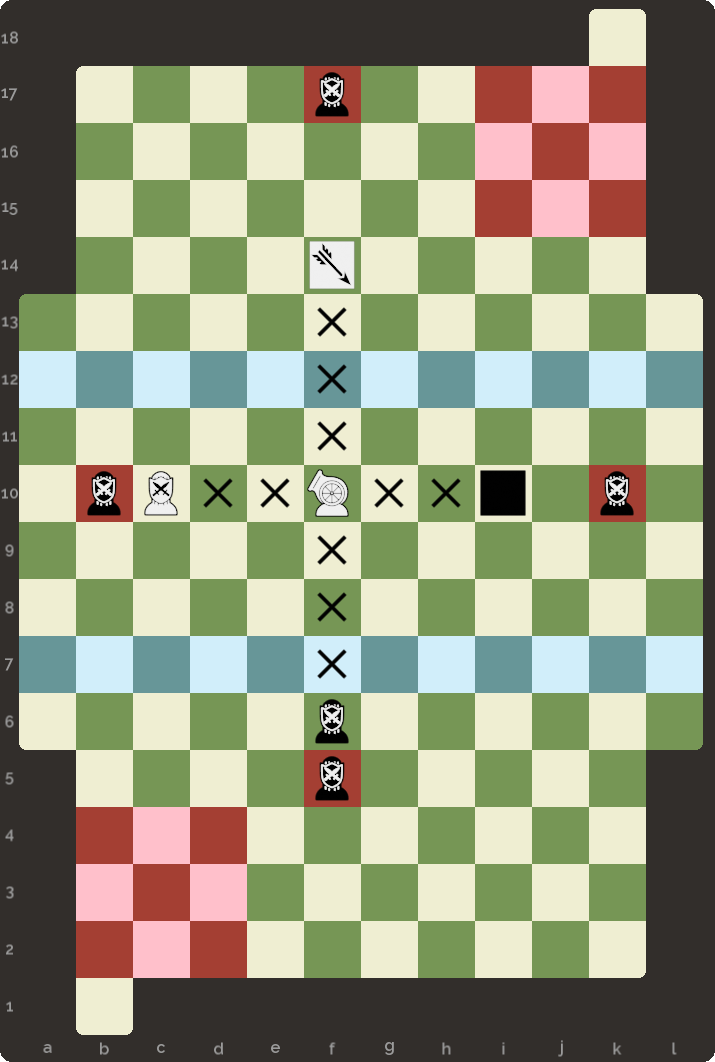
Knight:
The Knight moves and captures like the Knight in chess. It can jump over all pieces, also over arrows and dropped bombs.
It can jump past blocks (two squares horizontally and then one square vertically or vice versa) if possible.
The Knight (as the only piece) can remove supplementary stones (arrows and blocks) from the board and thus from the game in the same way as supplementary stones are placed. Bombs that have been dropped cannot be removed.
From the current position, the block and the arrow could be removed from the Knight (see diagram)

Notes
Bollwerk 178 is a commercial chess variant on a board with 178 squares. Author: Stefan Bogdanski
https://www.bollwerk178.com/en/
Over 3000 moves are available for just the first move, so that opening theory isn't very important in Bollwerk 178.
 This 'user submitted' page is a collaboration between the posting user and the Chess Variant Pages. Registered contributors to the Chess Variant Pages have the ability to post their own works, subject to review and editing by the Chess Variant Pages Editorial Staff.
This 'user submitted' page is a collaboration between the posting user and the Chess Variant Pages. Registered contributors to the Chess Variant Pages have the ability to post their own works, subject to review and editing by the Chess Variant Pages Editorial Staff.
By Stefan Bogdanski.
Last revised by Ben Reiniger.
Web page created: 2021-01-22. Web page last updated: 2021-03-06
